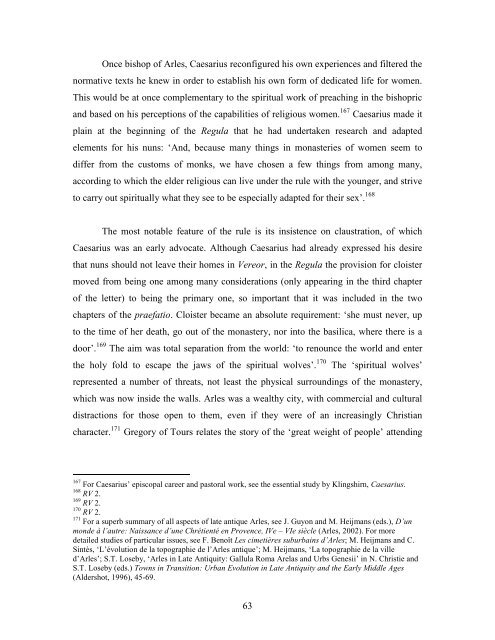Lindsay Rudge PhD Thesis - University of St Andrews
Lindsay Rudge PhD Thesis - University of St Andrews
Lindsay Rudge PhD Thesis - University of St Andrews
You also want an ePaper? Increase the reach of your titles
YUMPU automatically turns print PDFs into web optimized ePapers that Google loves.
Once bishop <strong>of</strong> Arles, Caesarius reconfigured his own experiences and filtered the<br />
normative texts he knew in order to establish his own form <strong>of</strong> dedicated life for women.<br />
This would be at once complementary to the spiritual work <strong>of</strong> preaching in the bishopric<br />
and based on his perceptions <strong>of</strong> the capabilities <strong>of</strong> religious women. 167 Caesarius made it<br />
plain at the beginning <strong>of</strong> the Regula that he had undertaken research and adapted<br />
elements for his nuns: ‘And, because many things in monasteries <strong>of</strong> women seem to<br />
differ from the customs <strong>of</strong> monks, we have chosen a few things from among many,<br />
according to which the elder religious can live under the rule with the younger, and strive<br />
to carry out spiritually what they see to be especially adapted for their sex’. 168<br />
The most notable feature <strong>of</strong> the rule is its insistence on claustration, <strong>of</strong> which<br />
Caesarius was an early advocate. Although Caesarius had already expressed his desire<br />
that nuns should not leave their homes in Vereor, in the Regula the provision for cloister<br />
moved from being one among many considerations (only appearing in the third chapter<br />
<strong>of</strong> the letter) to being the primary one, so important that it was included in the two<br />
chapters <strong>of</strong> the praefatio. Cloister became an absolute requirement: ‘she must never, up<br />
to the time <strong>of</strong> her death, go out <strong>of</strong> the monastery, nor into the basilica, where there is a<br />
door’. 169 The aim was total separation from the world: ‘to renounce the world and enter<br />
the holy fold to escape the jaws <strong>of</strong> the spiritual wolves’. 170 The ‘spiritual wolves’<br />
represented a number <strong>of</strong> threats, not least the physical surroundings <strong>of</strong> the monastery,<br />
which was now inside the walls. Arles was a wealthy city, with commercial and cultural<br />
distractions for those open to them, even if they were <strong>of</strong> an increasingly Christian<br />
character. 171 Gregory <strong>of</strong> Tours relates the story <strong>of</strong> the ‘great weight <strong>of</strong> people’ attending<br />
167<br />
For Caesarius’ episcopal career and pastoral work, see the essential study by Klingshirn, Caesarius.<br />
168<br />
RV 2.<br />
169<br />
RV 2.<br />
170<br />
RV 2.<br />
171<br />
For a superb summary <strong>of</strong> all aspects <strong>of</strong> late antique Arles, see J. Guyon and M. Heijmans (eds.), D’un<br />
monde à l’autre: Naissance d’une Chrétienté en Provence, IVe – VIe siècle (Arles, 2002). For more<br />
detailed studies <strong>of</strong> particular issues, see F. Benoît Les cimetières suburbains d’Arles; M. Heijmans and C.<br />
Sintès, ‘L’évolution de la topographie de l’Arles antique’; M. Heijmans, ‘La topographie de la ville<br />
d’Arles’; S.T. Loseby, ‘Arles in Late Antiquity: Gallula Roma Arelas and Urbs Genesii’ in N. Christie and<br />
S.T. Loseby (eds.) Towns in Transition: Urban Evolution in Late Antiquity and the Early Middle Ages<br />
(Aldershot, 1996), 45-69.<br />
63

















